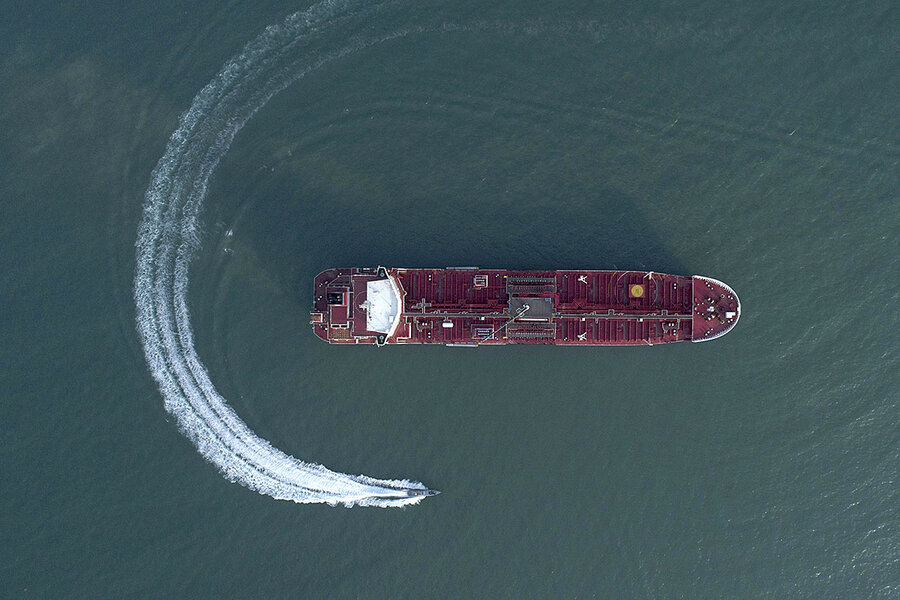Behind Iran spy drama, a broader escalation
Loading...
| London
In the latest escalation of a covert intelligence war between the United States and Iran, the Islamic Republic announced Monday it had broken up an American spy network last year by arresting 17 Iranian nationals who had been recruited and trained by the CIA.
Iranian intelligence officials produced a polished video that purported to illustrate how U.S. agents had recruited Iranians outside the country with promises of visas and cash, had delivered encrypted communications gear encased in bricks, and had tasked the agents with spying on Iranian nuclear and military sites.
Iranian media also published photographs they claimed were of American handlers, along with documents, business cards, and contact details purportedly of U.S. diplomats and their recruits. Of the 17 arrested, those who refused to cooperate as double-agents to work against the U.S. face the death penalty.
Why We Wrote This
The timing of Iran’s declaration today that it captured 17 Iranians last year who were trained by the CIA signals a renewal of the U.S.-Iran covert war, amid a series of escalatory moves.
President Donald Trump rejected the Iranian claims, saying in a tweet that reports of Iran “capturing CIA spies is totally false. Zero truth. Just more lies and propaganda.” Secretary of State Mike Pompeo said Iranian claims should be taken with a “grain of salt,” and that Iran had a “history of lying.”
While Iran does have a history of falsely accusing detainees of being spies – Washington Post correspondent Jason Rezaian was accused by his Iranian interrogators during 544 days in prison of being the CIA “station chief” in Tehran – there are also several signs that Iran may have, in fact, had access to U.S. intelligence networks targeting it.
As events unfold in the coming days and weeks, and U.S.-Iran tensions continue to escalate, here are several key points of context:
Part of a broader surge in tensions
First, Iran’s declaration of dealing a “heavy blow” to CIA networks appears timed to add to a surge of tension in recent weeks that has seen American sanctions on Iran bite deeper, Iran shoot down a state-of-the-art U.S. intelligence drone, and Mr. Trump call off a surgical strike on Iran with just minutes to spare.
In the narrow shipping channels of the Persian Gulf, through which 20% of global oil supplies pass daily, Iran last week seized a British-owned oil tanker, and since May half a dozen tankers have been damaged by explosions that the U.S. blames on Iran. The latest move was a clear response to British Royal Marines seizing a tanker full of Iranian crude off the coast of Gibraltar earlier this month.
The escalation began one year ago, triggered by Mr. Trump withdrawing the U.S. from the landmark 2015 nuclear deal between Iran and six world powers, and reimposing American sanctions.
Stepping up the U.S.-Iran covert war is one facet of that broader stand-off, not unlike the intense covert activity that preceded the nuclear negotiations. Actions then included President Barack Obama launching cyberattacks against Iran’s nuclear infrastructure through the Stuxnet virus, and the assassination – widely attributed to Israel’s Mossad intelligence agency – of several Iranian nuclear scientists in Tehran.
CIA communication system compromised 2009-2013
Second, Iran’s latest claims of rolling up a CIA spy network come after investigative reporting by Yahoo revealed last November that, from 2009 to 2013, the CIA’s internet-based system to communicate with far-flung operatives had been compromised. The breakdown originated in Iran, which started hunting for a mole after the Obama administration announced the discovery of a secret Iranian enrichment facility in 2009, and “spiderwebbed” to other countries, Yahoo reported.
More than two dozen American intelligence sources died in China in 2011 and 2012 as a result, and Iran also began to announce the capture of networks of spies working for the U.S.
Yahoo cited interviews with multiple former intelligence officials, who called the resulting damage “serious – even catastrophic” and likely to “persist for years.”
U.S. counterintelligence officer’s defection & new tactics
Third is the little-noticed story of the 2013 defection to Iran of former U.S. Air Force counterintelligence officer Monica Witt. A Justice Department indictment made public in February charged her with revealing classified information to Iran, and specifically with exposing U.S. operatives to being targeted.
An unnamed senior Iranian intelligence official told foreign news media in Tehran on Monday that there had been a marked intensification of CIA activity against Iran since Mr. Trump’s 2016 election and his appointment last year of Gina Haspel as CIA director.
The Iranian documentary, called “Hunting the Spies,” boasted of Iran’s ability to counter what it called a new American tactic of hiring spies to infiltrate key institutions. “The new mission of the U.S. was taking lessons from the past, particularly its massive intelligence defeats in 2013,” says the 19-minute Ministry of Intelligence film.
The video includes audio from purported wiretaps, with incidents from Afghanistan to Thailand to Sweden, where an Iranian with her face blurred out, who is apparently a student, describes how she was recruited by the CIA there. Among other scenes, the video also shows an unidentified blonde woman speaking Persian with an American accent, who says she is in Dubai, saying it is “dangerous” because Iranian intelligence is “spread everywhere.”
“We decided that we shouldn’t wait to be targeted by their spies,” Minister of Intelligence Mahmoud Alavi says in the video, which describes a shift from passive defense to active defense. “We infiltrated the very source of their attacks, when they were working on their plots.”





